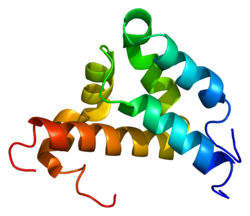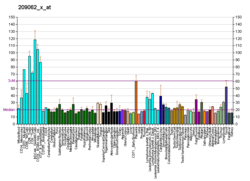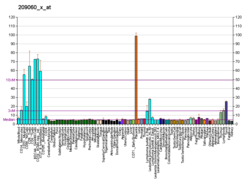核内受容体コアクチベーター3
核内受容体コアクチベーター3(NCOA3: nuclear receptor coactivator 3)は、ヒトのNCOA3遺伝子によってコードされているタンパク質である[5][6]。AIB1(amplified in breast 1)、SRC-3(steroid receptor coactivator-3)、またはTRAM-1(thyroid hormone receptor activator molecule 1)とも呼ばれる。
機能
編集NCOA3は、いくつかの核内受容体相互作用ドメインと固有のヒストンアセチルトランスフェラーゼ活性を有する転写共制御タンパク質である。NCOA3は、リガンド活性型核内受容体によってDNAのプロモーター部位に動員される。そしてNCOA3はヒストンをアセチル化し、下流のDNAの転写を容易にする。したがって、NCOA3はDNA発現の上方調節において核内受容体を支援する[6][5]。
臨床的な意義
編集NCOA3あるいはAIB1のタンパク質発現に対するペアードボックス転写因子2(PAX2)のそれの比率は、乳癌治療におけるタモキシフェンの有効性予測を可能にする可能性がありる[7][8]。
いくつかの分子メカニズムの観測結果は、NCOA3が乳癌の内分泌療法への耐性に関係していることを示す。ERKおよび/またはPIK3CA/AKTキナーゼ経路の持続的な活性化につながるシグナル伝達経路または変異(例えば、HER2/neu過剰発現、PIK3CA(PI3K)の活性化突然変異、癌原遺伝子チロシンプロテインキナーゼSrcの活性化変異など) は、一方ではNCOA3転写共活性化能力を増強し[9]、他方ではプロテアソーム依存性NCOA3ターンオーバーの阻害することによってNCOA3の過剰発現を引き起こす[10]。どちらの条件でも、エストロゲン受容体(ER)複合体形成の平衡は、転写活性複合体に向かって変位し、したがって、タモキシフェンやフルベストラント(選択的エストロゲン受容体モジュレーター)などの抗エストロゲン薬によって引き起こされる阻害を打ち消す。その結果、エストロゲン感受性遺伝子の転写が回復し、癌の進行および/または再発が促進される。
特に、NCOA3とHER2/neuの同時過剰発現と診断された腫瘍患者は、他のすべての患者を合わせた場合よりもタモキシフェン療法の結果が悪かった[11]。さらに、内分泌療法で治療された管腔形成乳癌の休眠腫瘍細胞は、キナーゼシグナル伝達経路を変化させて最終的にNCOA3発癌機能を増強する突然変異を時間とともに獲得する可能性がある。また、エストロゲン受容体-PAX2複合体はHER2/neuの発現を抑制するが、PAX2の発現が失われると、新たにHER2/neuの発現が起こり、内分泌療法の耐性と再発が始まる可能性がありる[12]。
相互作用分子
編集核内受容体コアクチベーター3は、以下の生体分子と相互作用する。
脚注
編集
- ^ a b c GRCh38: Ensembl release 89: ENSG00000124151 - Ensembl, May 2017
- ^ a b c GRCm38: Ensembl release 89: ENSMUSG00000027678 - Ensembl, May 2017
- ^ Human PubMed Reference:
- ^ Mouse PubMed Reference:
- ^ a b Sarah L. Anzick, Juha Kononen, Robert L. Walker, David O. Azorsa, Minna M. Tanner, Xin-Yuan Guan, Guido Sauter, Olli-P. Kallioniemi, Jeffrey M. Trent, Paul S. Meltzer (15 Aug 1997). “AIB1, a steroid receptor coactivator amplified in breast and ovarian cancer”. Science 277 (5328): 965–8. doi:10.1126/science.277.5328.965. PMID 9252329.
- ^ a b Akira Takeshita, Guemalli R. Cardona, Noriyuki Koibuchi, Chen-Shian Suen, William W. Chin (31 Oct 1997). “TRAM-1, A novel 160-kDa thyroid hormone receptor activator molecule, exhibits distinct properties from steroid receptor coactivator-1”. Journal of Biological Chemistry 272 (44): 27629–34. doi:10.1074/jbc.272.44.27629. PMID 9346901.
- ^ “Study sheds new light on tamoxifen resistance”. Cordis News. Cordis (2008年11月13日). 2008年11月14日閲覧。
- ^ Antoni Hurtado, Kelly A. Holmes, Timothy R. Geistlinger, Iain R. Hutcheson, Robert I. Nicholson, Myles Brown, Jie Jiang, William J. Howat, Simak Ali & Jason S. Carroll (01 Dec 2008). “Regulation of ERBB2 by oestrogen receptor-PAX2 determines response to tamoxifen”. Nature 456 (7222): 663–6. doi:10.1038/nature07483. PMC 2920208. PMID 190054696
- ^ Jaime Font de Mora and Myles Brown (July 2000). “AIB1 is a conduit for kinase-mediated growth factor signaling to the estrogen receptor”. Molecular and Cellular Biology 20 (14): 5041–7. doi:10.1128/MCB.20.14.5041-5047.2000. PMC 85954. PMID 10866661.
- ^ Macarena Ferrero, Alvaro Avivar, María Carmen García-Macías, Jaime Font de Mora (2008 Jul 1). “Phosphoinositide 3-kinase/AKT signaling can promote AIB1 stability independently of GSK3 phosphorylation”. Cancer Research 68 (13): 5450–9. doi:10.1158/0008-5472.CAN-07-6433. PMID 18593948.
- ^ C. Kent Osborne, Valerie Bardou, Torsten A. Hopp, Gary C. Chamness, Susan G. Hilsenbeck, Suzanne A. W. Fuqua, Jiemin Wong, D. Craig Allred, Gary M. Clark, Rachel Schiff (05 Mar 2003). “Role of the estrogen receptor coactivator AIB1 (SRC-3) and HER-2/neu in tamoxifen resistance in breast cancer”. Journal of the National Cancer Institute 95 (5): 353–61. doi:10.1093/jnci/95.5.353. PMID 126185006
- ^ Antoni Hurtado, Kelly A Holmes, Timothy R Geistlinger, Iain R Hutcheson, Robert I Nicholson, Myles Brown, Jie Jiang, William J Howat, Simak Ali, Jason S Carroll (2008 Dec 4). “Regulation of ERBB2 by oestrogen receptor-PAX2 determines response to tamoxifen”. Nature 456 (7222): 663–6. doi:10.1038/nature07483. PMC 2920208. PMID 190054696
- ^ Jiann-an Tan, Susan H. Hall, Peter Petrusz, Frank S. French (2000 Sep). “Thyroid receptor activator molecule, TRAM-1, is an androgen receptor coactivator”. Endocrinology 141 (9): 3440–50. doi:10.1210/endo.141.9.7680. PMID 10965917.
- ^ V. J. Gnanapragasam, H. Y. Leung, A. S. Pulimood, D. E. Neal, C. N. Robson (11 Dec 2001). “Expression of RAC 3, a steroid hormone receptor co-activator in prostate cancer”. British Journal of Cancer 85 (12): 1928–36. doi:10.1054/bjoc.2001.2179. PMC 2364015. PMID 11747336.
- ^ Qianben Wang, T S Udayakumar, Tadas S Vasaitis, Angela M Brodie, Joseph D Fondell (2004 Apr 23). “Mechanistic relationship between androgen receptor polyglutamine tract truncation and androgen-dependent transcriptional hyperactivity in prostate cancer cells”. Journal of Biological Chemistry 279 (17): 17319–28. doi:10.1074/jbc.M400970200. PMID 14966121.
- ^ a b c d Ray-Chang Wu, Jun Qin, Yoshihiro Hashimoto, Jiemin Wong, Jianming Xu, Sophia Y. Tsai, Ming-Jer Tsai, and Bert W. O'Malley (May 2002). “Regulation of SRC-3 (pCIP/ACTR/AIB-1/RAC-3/TRAM-1) Coactivator activity by I kappa B kinase”. Molecular and Cellular Biology 22 (10): 3549–61. doi:10.1128/MCB.22.10.3549-3561.2002. PMC 133790. PMID 11971985.
- ^ Angela Naltner, Susan Wert, Jeffrey A. Whitsett, and Cong Yan (01 Dec 2000). “Temporal/spatial expression of nuclear receptor coactivators in the mouse lung”. American Journal of Physiology-Lung Cellular and Molecular Physiology 279 (6): L1066-74. doi:10.1152/ajplung.2000.279.6.l1066. PMID 11076796.
- ^ a b c Michiko Watanabe, Junn Yanagisawa, Hirochika Kitagawa, Ken-ichi Takeyama, Satoko Ogawa, Yukitomo Arao, Miyuki Suzawa, Yoko Kobayashi, Tetsu Yano, Hiroyuki Yoshikawa, Yoshikazu Masuhiro, Shigeaki Kato (15 Mar 2001). “A subfamily of RNA-binding DEAD-box proteins acts as an estrogen receptor alpha coactivator through the N-terminal activation domain (AF-1) with an RNA coactivator, SRA”. The EMBO Journal 20 (6): 1341–52. doi:10.1093/emboj/20.6.1341. PMC 145523. PMID 11250900.
- ^ a b Chi-Wai Wong, Barry Komm, and Boris J. Cheskis (2001 Jun 12). “Structure-function evaluation of ER alpha and beta interplay with SRC family coactivators. ER selective ligands”. Biochemistry 40 (23): 6756–65. doi:10.1021/bi010379h. PMID 11389589.
- ^ Minna K. Tikkanen, Damien J. Carter, Alana M. Harris, Hung M. Le, David O. Azorsa, Paul S. Meltzer, and Fern E. Murdoch (7 Nov 2000). “Endogenously expressed estrogen receptor and coactivator AIB1 interact in MCF-7 human breast cancer cells”. PNAS 97 (23): 12536–40. doi:10.1073/pnas.220427297. PMC 18799. PMID 11050174.
- ^ Christopher Leo, Hui Li, J. Don Chen (25 Feb 2000). “Differential mechanisms of nuclear receptor regulation by receptor-associated coactivator 3”. Journal of Biological Chemistry 275 (8): 5976–82. doi:10.1074/jbc.275.8.5976. PMID 10681591.
- ^ Pei-Wen Hsiao, Christy J Fryer, Kevin W Trotter, Weidong Wang, Trevor K Archer (September 2003). “BAF60a mediates critical interactions between nuclear receptors and the BRG1 chromatin-remodeling complex for transactivation”. Molecular and Cellular Biology 23 (17): 6210–20. doi:10.1128/MCB.23.17.6210-6220.2003. PMC 180928. PMID 12917342.
- ^ Johanna Zilliacus, Elin Holter, Hideki Wakui, Hiroshi Tazawa, Eckardt Treuter, Jan-Åke Gustafsson (01 Apr 2001). “Regulation of glucocorticoid receptor activity by 14--3-3-dependent intracellular relocalization of the corepressor RIP140”. Molecular Endocrinology 15 (4): 501–11. doi:10.1210/mend.15.4.0624. PMID 11266503.
- ^ Yasuo Kodera, Ken-ichi Takeyama, Akiko Murayama, Miyuki Suzawa, Yoshikazu Masuhiro, Shigeaki Kato (27 Oct 2000). “Ligand type-specific interactions of peroxisome proliferator-activated receptor gamma with transcriptional coactivators”. Journal of Biological Chemistry 275 (43): 33201–4. doi:10.1074/jbc.C000517200. PMID 10944516.
- ^ Hongwu Chen, Richard J. Lin, R. Louis Schiltz, Debabrata Chakravarti, Alyssa Nash, Laszlo Nagy, Martin L. Privalsky, Yoshihiro Nakatani, Ronald MEvans (8 Aug 1997). “Nuclear receptor coactivator ACTR is a novel histone acetyltransferase and forms a multimeric activation complex with P/CAF and CBP/p300”. Cell 90 (3): 569–80. doi:10.1016/S0092-8674(00)80516-4. PMID 9267036.
- ^ Wen-yi Lee, Noa Noy (26 Feb 2002). “Interactions of RXR with coactivators are differentially mediated by helix 11 of the receptor's ligand binding domain”. Biochemistry 41 (8): 2500–8. doi:10.1021/bi011764+. PMID 11851396.







